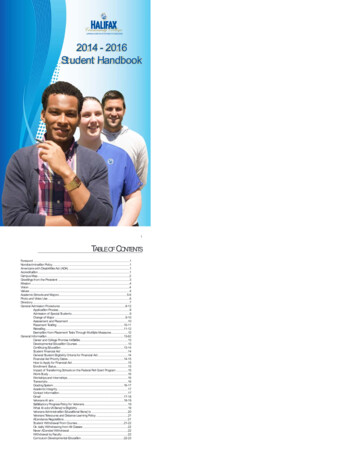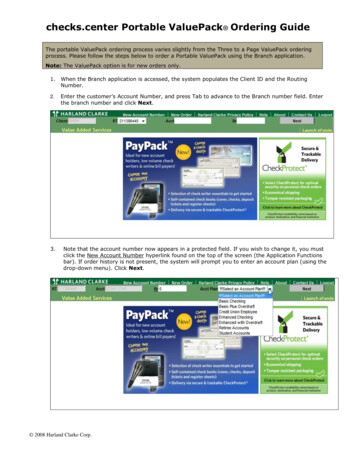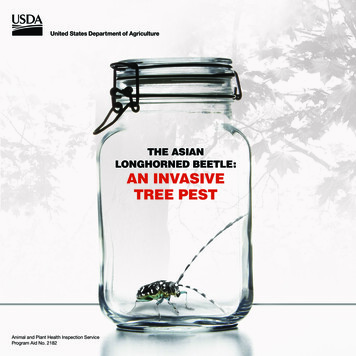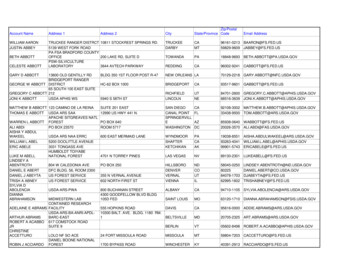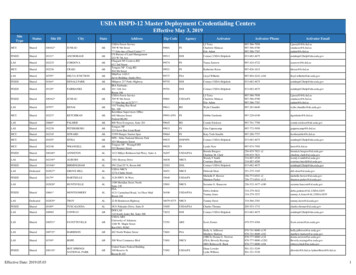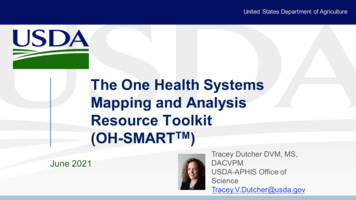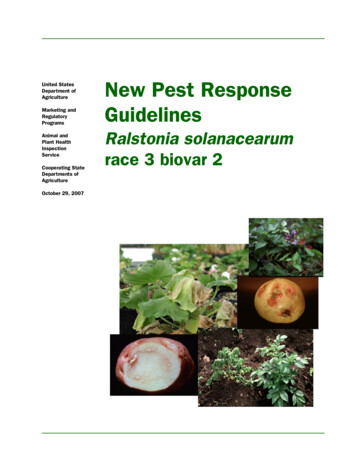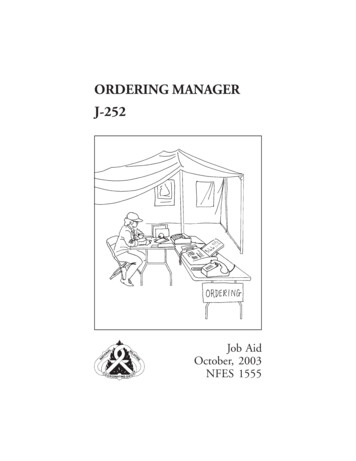
Transcription
ORDERING MANAGERJ-252Job AidOctober, 2003NFES 1555
ORDERING MANAGERJ-252Job AidOctober, 2003NFES 1555Sponsored for NWCG publication by the NWCG Training Working TeamComments regarding the content of this publication should be directed to:National Interagency Fire Center, National Fire Training Support Group, 3833S. Development Ave., Boise, Idaho 83705. Email:nwcg standards@nifc.blm.gov.Additional copies of this publication may be ordered from National InteragencyFire Center, ATTN: Great Basin Cache Supply Office, 3833 South Development Avenue, Boise, Idaho 83705. Order NFES 1555.
TABLE OF CONTENTSINTRODUCTION .4I.GENERALObtain and Assemble Materials Needed forKit .7Documentation Forms .7Miscellaneous Items . 8II.MOBILIZATIONA. Information from Local Dispatch Upon InitialActivation.9B. Gather Information . 10III.INCIDENT ACTIVITIESA. Incident and Check-in . 11B. Briefing from Supply Unit Leader (SUPL) .11C. Establish Ordering Procedures . 13D. Written Request for Supplies andResources . 15E. Establish Ordering Channels . 161
TABLE OF CONTENTS (continued)F. Maintain Filing System . 19G. Reconcile Resource Orders . 19H. Notification to Receiving and DistributionManager (RCDM) of Placed Orders . 20I. Briefing Subordinate(s) and ReliefPersonnel . 21J. Coordination with Appropriate Personnel . 22K. Reports Required by the SUPL . 23L. Evaluate Performance of Subordinate(s) . 23IV.DEMOBILIZATIONA. Demobilization of Incident Supplies andEquipment . 23B. Demobilization of Ordering UnitPersonnel . 252
TABLE OF CONTENTS (continued)APPENDICESAppendix A, Check-out Authority . 27Appendix B, ICS 213, General Message,Example . 29Appendix C, Resource Order Examples andInstructions . 31Appendix D, 24-Hour Clock . 43Appendix E, Glossary of Terms andAcronyms . 453
ORDERING MANAGER (ORDM)JOB AID, J-252 INTRODUCTIONThe Ordering Manager has been identified as aposition within the Incident Command System(ICS). The J-252 job aid, which supports thisposition, is part of the National WildfireCoordination Group's (NWCG), Wildland FireSuppression Curriculum. The subjects within theperformance based curriculum may beadministered by either an instructor led formaltraining course or by the use of job aids. It is highlysuggested that the trainee have previous incidentexperience.Job aids are "how to" books that assist an individualin performing specific tasks associated with aposition. They may be used by an individual, in atrainee position, who has met all of theprerequisites, but has not completed the positiontask book for that position. They are also used afterthe individual has become qualified, as an aid orrefresher in doing the job.The performance based qualification systemstipulates that an individual must complete aPosition Task Book prior to becoming qualified forthat position. Refer to the "Wildland andPrescribed Fire Qualification System Guide, PMS310-1" for the established standards for thisposition. It is recommended that this job aid beissued when the position task book is initiated.4
This job aid has been developed by an interagencydevelopment group with guidance from the NationalInteragency Fire Center, Fire Training underauthority of the NWCG, with coordination andassistance of personnel from the followingagencies:UNITED STATES DEPARTMENT OF THEINTERIORBureau of Land ManagementTrenna ButlerEd RyanMarianne SchappekUNITED STATES DEPARTMENT OFAGRICULTUREForest ServiceLynn BurtonDEPARTMENT OF NATURAL RESOURCESState of Wisconsin, Division of ForestryKen TerrillNATIONAL INTERAGENCY FIRE CENTERFire Training, NWCG Development UnitKarin NicholsJan HendrickWe appreciate the efforts of those peopleassociated with the development and review of thispackage.5
Sponsored for NWCG publication by the NWCGTraining Working Team, October, 2003.Comments regarding the content of this publicationshould be directed to: National Interagency FireCenter, Fire Training, 3833 South DevelopmentAvenue, Boise, Idaho 83705.Email: nwcg standards@nifc.blm.govAdditional copies of this publication may beordered from: National Interagency Fire Center,ATTN: Great Basin Cache Supply Office, 3833 S.Development Avenue, Boise, Idaho 83705. OrderNFES #1555.6
I.GENERALObtain and Assemble Materials Needed forKit.Kit will be assembled and prepared prior toreceiving an assignment. Kit will containcritical items needed for functioning duringthe first 48 hours. Kit will be easilytransportable and within agency weightlimitation. Web gear or briefcase (not both)should not exceed 20 pounds. Proof of Incident qualifications (Red Card) Position Task book, NFES 2353 Fireline Handbook, PMS 410-1, NFES0065 Expanded Dispatch Job Aid, NFES 2400 National Fire Equipment System Catalog,NFES 0362 Mnemonics data table National Mobilization Guide, NFES 2092Documentation Forms: ICS 213, General Message, NFES 1336 ICS 214, Unit Log, NFES 1337 ICS 219, Resource Status Card (T-Card),NFES 1342 and holder (optional) ICS 226, Individual Performance Rating,NFES 20747
SF-261, Crew Time Report, NFES 0891and/or OF-288 Emergency FirefighterTime Report, NFES 0866 OF-289 Property Loss or Damage Report,NFES 1864 OF-315 Incident Replacement Requisition,NFES 1300 OF-316 Interagency Incident Waybill,NFES 1472 Resource Order forms, NFES 2200-2216 Food Service Request Infrared Aircraft Scanner Request Agency specific forms, e.g., requisitionforms.Miscellaneous Items (optional): Assorted pens, pencils, felt tip markers,highlighters, thumb tacks, string tags, padsof paper, clipboard, masking/strappingtape, duct tape, envelopes, surveyorflagging, file system supplies, hole punch,etc. Calculator Flashlight (extra batteries) Alarm clock Camera Calendar Tape measure Insect repellent Local area maps Road atlas Laptop computer8
II.MOBILIZATIONA.Obtain Complete Information From LocalDispatch Upon Initial Activation.1.Obtain a copy of the order form whichcontains: Incident/Project nameIncident/Project order numberOffice reference number (costcode)Descriptive location/responseareaLegal location (township, range,section)Incident frequencies (if available)Incident base/phone number(contact)Request numberReporting date/time and location,e.g., Incident Command Post(ICP)Transportation arrangements androutesSpecial instructionsRetain a copy of this order form for yourpersonal fire experience record.9
2.The individual will have: B.Frameless soft pack containingpersonal gear, not to exceed 45lb.ORDM kit, not to exceed 20 lb.Proper Personal ProtectiveEquipment (PPE) for the job.Gather InformationGather all available information necessary toaccurately assess incident; make appropriatedecisions about immediate needs andactions including: Type of incidentPlanned operations, e.g., multipleremote camps, burnoutoperations, water handlingoperations.Current situation statusExpected duration of incidentTerrainWeather (current and expected)10
III.INCIDENT ACTIVITIESA.Arrive at Incident and Check In B.Locate supervisor (supply unit leader;SUPL.)Report to status check-in recorder andcomplete ICS 211, Check-in List.Report to the finance/administrationsection for time keeping procedures.Obtain Briefing from the SUPL.You are responsible for asking adequatequestions that will allow satisfactorycompletion of all job aspects. There are nostupid questions. Briefing should include asa minimum: Sleeping and eating arrangements.Location of your work area.Copies of resource order forms ofsupplies and resources that have beenordered and received.Personnel ordered for your function,work schedule, policy and operatingprocedures, and chain of command inyour unit.Projections for additional personnel andequipment, approximate time andnumbers.11
Responsible agency’s ordering policiesand procedures.Sources of suppliesWhere and with whom do I placeorders?Phone number(s)?Expanded dispatchAgency dispatch officeBuying teamIncident - all functional areasVendor/contractor(s)Fax numbersCachePeople you will interface with on theincident.Unit leaders and staffExpanded dispatchBuying teamProcurement lead times required forfood, tools, fuel, etc.Type of communications available.Fax, radios, phones, cell phones,computersLocation of computer work station(s), ifused.Identify office needs.Established/needed securityprocedures.Procurement restrictionsExamples: flight suits, tents, brushjackets, commissary items,supplemental foods.12
Establish briefing procedures within thesupply unit.Request a current copy of the IncidentAction Plan (IAP) and incident map.Supply Unit dersRecordersHelpersTool andEquipmentSpecialistTool AttendantsC.Establish Ordering Procedures. Identify who has ordering authority.Crew boss, unit leaders, etc.See Appendix A, Check-out Authorityexample. Identify the source from which you areordering supplies, e.g., expandeddispatch, direct to fire cache, or directto the buying team.Identify type of tracking system beingused.Ensure the consolidation of identicalsupply requests.Check previous orders forduplication and verify forcorrectness.13
- Check with other unit leaders forpossibility of moving excessresources within the camp beforeordering more, e.g., portable toiletneeded for the helibase; checkwith the facilities unit leader(FACL).Identify who is responsible forassigning request numbers, e.g.,ordering manager, expanded dispatch,buying team.Follow resource order system fordocumenting requests for placementand completion of orders.Verify with ordering unit for anysupplemental items that may berequired to complete an order.Ensure that the person placing therequest has checked with receiving anddistribution for item(s) needed.Coordinate ordering timeframes withexpanded dispatch or other orderingpoints.If possible, meet face-to-face withagency personnel, e.g., expandeddispatch, buying team, and agencydispatch, you will be dealing with duringthese procedures.14
D.Receive Written Request for Supplies andResources Directly from Incident Personnelor Through the Incident CommunicationSystem.1.Request will be documented on a ICS213, General Message, legibly, andcontain the following information: Request date/time and date/timeneeded.NFES number (if applicable)Detailed description of item(s).Be specific with model numbers,brand names, size, etc.Number desired, units of issueAny special billing requirementsWhom to notify when item isdeliveredDelivery point(s)Name of requesting party andagencyAuthorized approvalSee Appendix B, ICS 213 General Messageexample15
2.Evaluate and check for supplementalitems needed to complete therequested resource(s). 3.E.Examples of these supplementalitems are:Helitorch order - otherneeds may include: gas,helicopter, module,mixmaster.1 ½” & 1” Hose ordered other needs may include:hose appliances, nozzles.Leaf blower - other needsmay include: extensions,straps, fuel.Notify the SUPL of requests forresources placed by unauthorizedpersonnel before placing order.Place Resource Orders Through EstablishedOrdering Channels.1.After receiving request on a ICS 213,General Message, transfer informationonto an appropriate resource orderform.16
A – Aircraft, including: air tankers single engine air tankers (SEAT) helicopters large air transport light fixed-wing frequencies Temporary Flight Restrictions(TFR)C – Crews, including: hand (Type 1, 2, 2 IA) camp inmateO-Overhead, including: incident management teams technical specialists (THSP)E-Equipment- Major fire fighting andsupport items, including: engines dozers caterers (food units) contract showers specialized itemsS-Supplies-, including: NFES cache itemsconsumable, durable, andaccountable propertyitems Items not available from the cacherented itemslocal purchase items17
When all items are released, reassigned, or ifall supplies have been shipped, the order isready to close. The expanded dispatch andthe supply unit must review the order andensure all necessary documentation iscomplete and the resources have beenreleased.See Appendix C for examples of resourceorder forms and instructions for filling out thisform.2.Place order via telephone, fax or radio,to either expanded dispatch or otherordering point.3.Receive request number that has beenmutually agreed upon. Record request number onto theoriginal ICS 213, GeneralMessage form and retain topcopy. Distribute the other copiesas follows:Copy to receiving anddistribution for supplies.Copy to the buying team ifapplicable.18
-F.Copy to requester whenorder has been confirmed.Notify requester of status oforder, especially if problemsare encountered.Set up and Maintain Filing System.Establish a filing system to track: The file system will be keptcurrent as resource orders areplaced or received.File original copy of generalmessage(s) by individual days orunit placing the order.Whether the system is a series of boxes, apiece of canvas with pockets, or a filingcabinet, does not matter as long as it isfunctional and works as a status keepingsystem.G.Reconcile Resource Orders. The ORDM is responsible forreconciling (balancing) orders.Using the resource order form, withinthe established length of time, ensureconfirmation that previously placedorders have been filled, killed,outstanding, or canceled.19
H.The ORDM must work closely with theRCDM, GSUL (ground support unitleader), resource unit, expandeddispatch, and buying team for feedbackon the arrivals of all items andpersonnel ordered.Progressively document, check andconfirm all new and existing resourceorders, including delivery times,method of delivery and location.Information is passed on to therequester as it becomes available.All problems or questions are broughtto the SUPL and documented in the unitlog.Keep RCDM Informed of Orders Placed. Ensure the pink copy of the ICS 213,General Message of suppliesrequested is given to the RCDM.Update the RCDM of pending deliveryof supplies.Update the planning and logisticssection of overhead and crew arrivalsfor additional meals needed andsleeping arrangements.20
I.Brief Subordinates and Relief Personnel.1.Staff briefings: 2.Initial briefingDaily briefing(s)New personnelSpecial problems, e.g.,injuriesChanges of policy andoperating procedures.Upcoming operationalneeds, e.g., burnout, remotecampsOutstanding ordersCanceled ordersSchedule changesSafety concerns, e.g., work/rest compliance, nutrition,work environment.Methods of Communication BriefingsICS 211, Check-in listICS 213, General MessageICS 214, Unit logResource order formWaybillsIncident Action Plan (IAP)21
3.Communication should: J.Be clear and conciseAsk questionsGet feedbackVerbally repeat orders to assureaccuracyInclude legible writingInteract and Coordinate with AppropriateIncident Personnel. Establish and maintain positiveinterpersonal and interagency workingrelationships.Establish and maintain communicationwith other unit leaders and staff.Recognize conflict early and takeappropriate action, e.g., seek the adviceof the logistics section chief (LSC),SUPL, or human resource specialist(HRSP).Recognize cultural language difficultiesthat impact work output andexpectations.Integrate cultural resourceconsiderations into all activities.22
K.Prepare and Submit Reports as Required bythe SUPL. L.Prepare ICS 214, Unit LogEvents that occur in the orderingunit.A list of the ORDM’s staff.Any major timetable problems.Any new policy guideline changes.Any problems encountered withsuppliers.Submit documents in a timely manner tomeet deadlines and/or incidentrequirements.Evaluate Performance of Subordinate(s) asRequired by Agency Policy. Performance evaluations are done forall unit personnel/crews prior to theirrelease from the incident. Performanceevaluations are discussed with theindividual(s).IV.DEMOBILIZATIONA.Demobilization of Incident Supplies andEquipment.Keep in mind demobilization begins when theincident starts23
1.Ongoing activities: 2.Refile orders in the “placed“ and“confirmed” files as their statuschanges.Check and determine if unfilledorders are still needed.Issue “S numbers” to crewsdemobilizing, if restock items arenot available at the incident, toenable them to order replacementitems at the home unit.Final demobilization: Complete reconciliation of allresource orders.Close out all resource orders andrecords with appropriate unit, e.g.,demobilization, expandeddispatch, initial attack aircraftdispatcher, procurement, buyingteam.If receiving and distribution cannotrestock unusable supplies orequipment, receive OF-289,Property Lost or DamagedReport; then prepare OF-351,Incident ReplacementRequisition.24
B.Turn all ordering records over tothe SUPL.Provide the SUPL or LSCinformation on unreconciledorders or resources that havenot been demobilized for inclusionin the Transfer of Command Plan.This information should also beprovided to expanded dispatch.Return all work materials to theappropriate unit.Return your work area to its preincident condition.Demobilization of Ordering Unit Personnel. Submit all required information to theSUPL.Receive demobilization instructionsfrom the SUPL.Brief replacement ORDM.Debrief with supervisor and receivesigned performance appraisal.Obtain ICS 221, DemobilizationCheckout, from the planning section.Check out with each section indicatedon the ICS 221.Submit completed ICS 221 to thedocumentation unit in the planningsection.25
26
APPENDIX ACHECKOUT AUTHORITY27
28
APPENDIX BICS 213, GENERAL MESSAGEOrdering ManagerChamberSmithOrder of suppliesDivision B Supervisor8/20 1945I need the following items for the day operational period, by 0600, 8/20I will pickup order1 ea. pump kit, NFES 06705 ea. reducers 1” x 3/4”, NFES 07335 ea. wye 3/4”, NFES 07395 ea. reducer 1 1/2” x 1”, NFES 00105 ea. nozzle 3/4” NFES 013610 LG Hose, garden, NFES 10165 LG Hose, 1”, NFES 09665 LG Hose, 1 1/2” , NFES 0114Smith, DIVS29
30
APPENDIX CRESOURCE ORDER, EXAMPLES31
APPENDIX C (continued)32
APPENDIX C (continued)33
APPENDIX C (continued)34
APPENDIX C (continued)35
APPENDIX C (continued)36
APPENDIX C (continued)37
APPENDIX C (continued)38
APPENDIX C (continued),39
APPENDIX C (continued)40
APPENDIX C (continued)41
42
APPENDIX D24-HOUR CLOCK12 Hour12345678910111212345678910111224 HourAM ————— 0100AM ————— 0200AM ————— 0300AM ————— 0400AM ————— 0500AM ————— 0600AM ————— 0700AM ————— 0800AM ————— 0900AM ————— 1000AM ————— 1100NOON ——— 1200PM ————— 1300PM ————— 1400PM ————— 1500PM ————— 1600PM ————— 1700PM ————— 1800PM ————— 1900PM ————— 2000PM ————— 2100PM ————— 2200PM ————— 2300Midnight——— 2400Pronounced——— Zero-one hundred——— Zero-two hundred——— Zero-three hundred——— Zero-four hundred——— Zero-five hundred——— Zero-six hundred——— Zero-seven hundred——— Zero-eight hundred——— Zero-nine hundred——— ten hundred——— eleven hundred——— twelve hundred——— thirteen hundred——— fourteen hundred——— fifteen hundred——— sixteen hundred——— seventeen hundred——— eighteen hundred——— nineteen hundred——— twenty hundred——— twenty-one hundred——— twenty-two hundred——— twenty-three hundred——— twenty-four hundredTo get 24 hour time, notice that you add 12 to the PM time to get the first twonumbers of the hour, i.e., 8 PM is twenty hundred (8 12 20).43
44
APPENDIX EGLOSSARY OF TERMS AND ACRONYMSFor additional fireline terms, refer to Wildland FireTerminology, PMS 205, NFES 1832AccountablePropertyItems with a purchase price of 5,000.00 or more or items thatthe agency considers sensitive(cameras, chainsaws, items withproperty numbers).A/CAircraft, fixed or rotor wing.ADAdministratively Determined (ratesand pay plan for emergencyworkers.)AGLAbove Ground Level, altitudeexpressed in feet above theground.AIDSAerial Ignition Devices - usuallyrefers to a ping pong ball machineor a helitorch.Air ContactParticular aviation resource tocontact when reporting to a fire.Air ShowMultiple aircraft over a fire, usuallyincluding air tankers.45
APPENDIX E (continued)Air TacticalICS position within the operationssection. Air Tactical GroupSupervisor (ATGS), synonymouswith air attack.AirA weather data collection andTransportable forecasting facility consisting ofModular Unitseven modules, weighing a total(ATMU)of 355 pounds and occupying34.2 cubic feet of space whentransported. Requires asupplemental order of helium,procured locally.Alumigel Jelly like substance produced bymixing gasoline and Alumigel powder. It is then applied with anignition device such as a helitorchto ignite fires.ALSAdvanced Life SupportATAActual Time of ArrivalAir TankerFixed wing aircraft capable ofdelivering fire retardant (liquid andfoam).ATDActual Time of Departure46
Av GasAPPENDIX E (continued)Fuel for aircraft with internalcombustion engines(reciprocating engines).AzimuthThe horizontal distance in angulardegrees in a clockwise directionfrom the north point.Back HaulExcess supplies, equipment ortrash returned from a location onan incident.BaseThe location at which primarylogistical functions for an incidentare coordinated and administered.There is only one base perincident, e.g., incident commandpost (ICP).BearingPosition of an object withreference to a point on acompass.BackpackPumpA collapsible backpack made ofneoprene or high strength nylonfabric that carries approximatelyfive gallons of water fittedwith a hand pump. (bladder bag)BDUBattle Dress Uniform; fire resistantpants47
APPENDIX E (continued)Black Water/Vehicle capable of pumping andSewage Truck hauling raw sewage (black water)to certified sewage treatmentfacility.Booster Pump An intermediary pump forsupplying additional lift in pumpingwater uphill past the capacity ofthe first pump.Casual(EFF)An employee who is picked uptemporarily for a fire emergency,see AD. Also referredto as Emergency Fire Fighter(EFF)Chief of PartyPerson in charge of passengerswhile traveling.ClamshellReusable battery holder for King radios. Holds 9 AA batteries.Listed as Holder, Battery, King,NFES 1034.CompressedAirFoam System(CAFS)A generic term used to describefoam systems consisting of an aircompressor (air source), waterpump and foam solution.CommoCommunications48
APPENDIX E (continued)ConsumablePropertyItems that are expected to beconsumed on the incident(batteries, MREs, canteens).CoordinationCenterRegional/Zone/State level centerfor mobilization of resources toincidents, etc. (dispatch)Coupling, hose A fitting on the end of a hose thatconnects the ends of adjacenthoses or other components ofhose, e.g., male, female, quickconnect, pin lug.Coyote Tactics A progressive line constructiontechnique involving self-sufficientcrews which build fire line until theend of the operational period,remain at or near that point while inan unavailable status and beginbuilding fireline at that point at thestart of the next operationalperiod.CSJRLCotton-Synthetic Jacketed,Rubber Lined hose.CubieCubitainer: a five gallon containerused for transporting drinkingwater.49
DemobAPPENDIX E (continued)Demobilization, process ofremoving resources, usually offincidents.DHSDepartment of Homeland SecurityDispatchDispatch center; a facility fromwhich resources are assigned toan incident.DivisionIncident division, usuallydesignated by a letter, e.g.,Division A.DJRLDouble Jacketed Rubber Linedhose.DozerA tracked vehicle with a frontmounted blade used for buildingfireline; bulldozer.Dozer tenderBulldozer service unitDrum LifterA device used to transport a 55gallon drum via a sling on ahelicopter.DurablePropertyNon-accountable items, withuseful life expectancy longer thanone incident.50
EngineAPPENDIX E (continued)A truck mounted with a pump andtank (water), used in firesuppression.EMSEmergency Medical ServiceEMTEmergency Medical TechnicianETAEstimated Time of ArrivalETDEstimated Time of DepartureETEEstimated Time En Route.ExpandedDispatchThe organization in dispatch that isactivated when the complexity oflogistics coordination approachesa level the initial attack dispatchorganization can no longersupport.FAAFederal Aviation AdministrationFBOFixed Base Operator; usually thelocal airport.51
Fill or KillAPPENDIX E (continued)Policy designed to indicate abilityto fill an order or if it can not befilled within a reasonable amountof time (1 hour is standard), then“kill” it. Determine whetherto reorder at a later time or cancelthe order. This policy isreferenced in the NationalInteragency Mobilization Guide.Fire CacheA supply of fire tools andequipment assembled in plannedquantities or standard units at astrategic point for exclusive use infire suppression.Fixed WingAircraft with stationary wings; anairplane.FLEFire Line Explosives, used forrapid construction of fire line witha small number of speciallytrained personnel.FMOFire Management Officer52
FoamAPPENDIX E (continued)An extinguishing agent, chemicallyand/or mechanically produced,that blankets and adheres to thefuels to reduce combustion.When foam products are mixed at1% or less, the foam will remaineffective at preventing ignition for12 hours. Works with currentclass A foam delivery systems.Fol-da-tank A portable, collapsible water tankwith a tubular frame; varies incapacity from 500-1500 gallons.FTSFederal Telephone SystemGated WyeA gated valve used in hose lays toallow connection of other hoseswithin the trunk line, e.g., 1” lateralhose with nozzle.GHTGarden Hose Thread, 3/4 inchhose fittingsGorman Rupp Small, portable water pump.Gray Water(Grey)Used water from the kitchen andshower units.GreenwichMeanTimeThe time at “0” longitude,Greenwich, England (Zulu time).53
APPENDIX E (continued)HazardousSubstances that are identified,Materialclassified and regulated in theCode of Federal Regulations,Title 49 and Hazardous MaterialsRegulation 175. A hazardousmaterial is a substance or materialwhich has been determined by theDepartment of Transportation tobe capable of posing anunreasonable risk to health, safetyand property when transported incommerce and which has been sodesignated.Head (waterpressure)Pressure due to elevation ofwater. Equals 0.433 pounds persquare inch per foot of elevation.HelibucketSpecially designed bucket carriedby a helicopter like a sling loadand used for aerial delivery ofwater or fire retardants.HelitorchAn aerial ignition device slungbeneath a helicopter to disperseignited lumps of jelled gasoline(Alumigel ).54
APPENDIX E (continued)Hot Food/Nonreusable cans that are used toDrink Cansship hot or cold drinks and food toremote locations.Hot Shots, IHC Specially trained seasonal handcrew (type 1).Hoverfill Tank Large, portable tank from whichhelitankers can hoverfill.IAInitial Attack, first effort tosuppress a fireICIncident CommanderImpellerRotating part of a centrifugalpump which imparts energy to theliquid to be moved. For shearingpurposes, the impeller is on arotating shaft within the body ofliquid.IMSRIncident Management SituationReport (Sit Report). Daily reportgiving the current fire situation inthe United States.IncidentAn event (fire, flood, earthquake,other disasters)55
APPENDIX E (continued)IncidentAn organization used to manageCommandan emergency incident or a nonSystem (ICS) emergency event. It can be usedequally well for both small andlarge situations. The system hasconsiderable internal flexibility. Itcan grow or shrink to meetdiffering needs. This makes it avery cost-effective and efficientmanagement system. Thesystem can be applied to a widevariety of emergency andnon-emergency situations.Incident Action Contains objectives reflecting thePlan (IAP)overall incident strategy andspecific control actions for thenext operational period. Theplan may be oral or written.IncidentOverheadAll supervisory positionsdescribed in the incidentcommand system.IncreaserIncreasing coupling used on hose,pump or nozzles to permitconnection of a larger size ofhose.56
InductorAPPENDIX E (continued)A control mechanism that allows aregulated quantity of foamconcentrate to be introduced intothe main hose line.InfraredA heat detection system used forfire detection, mapping and heatsource identification.InsideDiameterThe internal diameter of a tube,conductor or coupling asdistinguished from the outsidediameter. Fire hose sizes areclassified by a nominal internaldiameter.IR ScanInfrared survey of a fireIron PipeStandardThreadStandard system of thread forconnecting various types of rigidpiping. These threads are muchfiner and more difficult to connectin the field than National Standardthreads.KamlockType of fitting that provides quickconnecting/disconnecting hose.57
APPENDIX E (continued)Lead LineLine or set of lines made of rope,webbing or cable and used inhelicopter external loadoperations. Placed between aswivel or the cargo hook and theload.Lead PlaneAircraft with pilot used to maketrial runs over the target area tocheck wind, smoke conditions,topography and lead air tankersto the target.Lined FireHoseFire hose with a smooth innercoating of rubber or plastic toreduce friction loss.LiquidConcentrateLiquid phosp
ordering manager, expanded dispatch, buying team. Follow resource order system for documenting requests for placement and completion of orders. Verify with ordering unit for any supplemental items that may be required to complete an order. Ensure that the person placing the request has checked with receiving and distribution for .
